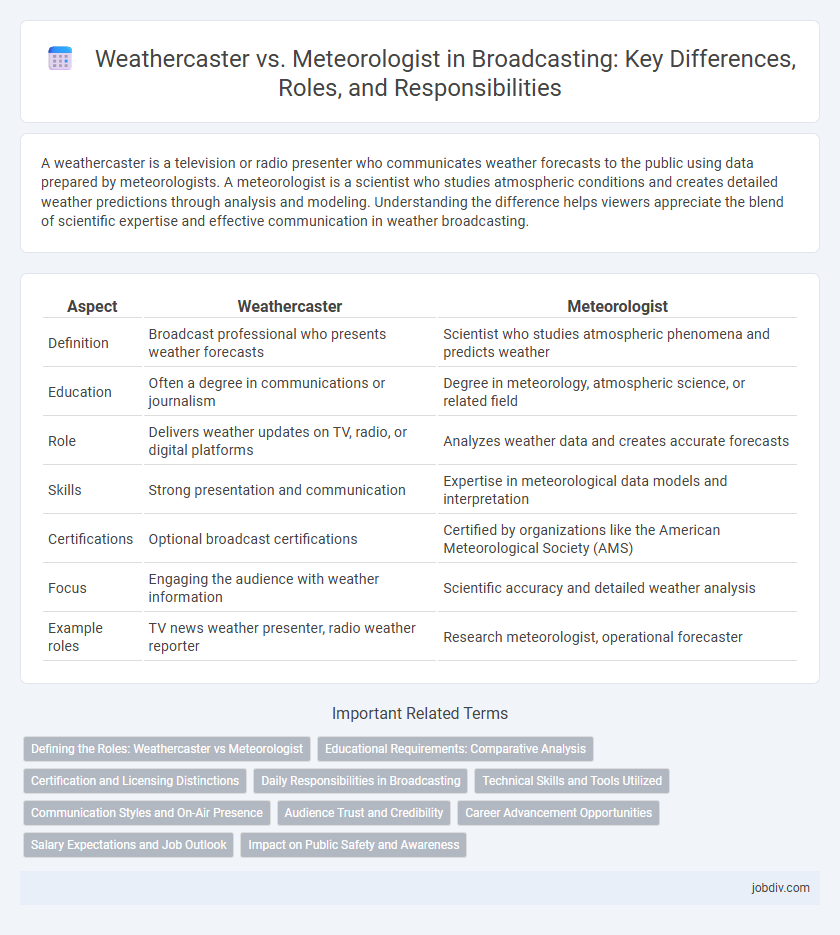A weathercaster is a television or radio presenter who communicates weather forecasts to the public using data prepared by meteorologists. A meteorologist is a scientist who studies atmospheric conditions and creates detailed weather predictions through analysis and modeling. Understanding the difference helps viewers appreciate the blend of scientific expertise and effective communication in weather broadcasting.
Table of Comparison
| Aspect | Weathercaster | Meteorologist |
|---|---|---|
| Definition | Broadcast professional who presents weather forecasts | Scientist who studies atmospheric phenomena and predicts weather |
| Education | Often a degree in communications or journalism | Degree in meteorology, atmospheric science, or related field |
| Role | Delivers weather updates on TV, radio, or digital platforms | Analyzes weather data and creates accurate forecasts |
| Skills | Strong presentation and communication | Expertise in meteorological data models and interpretation |
| Certifications | Optional broadcast certifications | Certified by organizations like the American Meteorological Society (AMS) |
| Focus | Engaging the audience with weather information | Scientific accuracy and detailed weather analysis |
| Example roles | TV news weather presenter, radio weather reporter | Research meteorologist, operational forecaster |
Defining the Roles: Weathercaster vs Meteorologist
Weathercasters deliver weather forecasts on television or radio, using meteorological data to inform the public but often without advanced scientific training. Meteorologists are scientists specializing in atmospheric sciences who analyze weather patterns, conduct research, and develop predictive models to understand and forecast weather phenomena accurately. The key distinction lies in meteorologists' comprehensive scientific expertise versus weathercasters' focus on communicating weather information effectively to audiences.
Educational Requirements: Comparative Analysis
Weathercasters typically possess a bachelor's degree in communications or journalism with specialized training in meteorology, while meteorologists hold advanced degrees, such as a bachelor's or master's in atmospheric sciences or meteorology. Meteorologists require extensive knowledge of physics, chemistry, and statistics to analyze and predict weather patterns accurately, whereas weathercasters focus on effectively communicating these forecasts to the public. Certification through organizations like the American Meteorological Society is often mandatory for meteorologists, enhancing credibility and expertise in the field.
Certification and Licensing Distinctions
Weathercasters primarily deliver weather forecasts on television or radio without requiring formal certification, relying on communication skills and basic meteorological knowledge. Meteorologists possess advanced degrees in atmospheric sciences and often hold certifications such as the Certified Broadcast Meteorologist (CBM) from the American Meteorological Society, which requires passing rigorous exams and demonstrated weather expertise. Licensing requirements vary by region, but meteorologists generally undergo more formal credentialing processes compared to weathercasters, who emphasize presentation rather than scientific analysis.
Daily Responsibilities in Broadcasting
Weathercasters deliver daily weather updates on television or radio, translating meteorological data into clear, understandable forecasts for a broad audience. Meteorologists analyze atmospheric data and use scientific models to predict weather patterns, often supporting weathercasters with accurate information. Both roles are crucial in broadcasting, but meteorologists focus on scientific accuracy while weathercasters emphasize communication and presentation.
Technical Skills and Tools Utilized
Weathercasters primarily use broadcasting software, radar imaging, and satellite data to deliver weather reports to the public, relying heavily on clear communication and presentation skills. Meteorologists apply advanced technical skills such as atmospheric modeling, data analysis, and interpreting complex climate data using tools like numerical weather prediction models and specialized sensors. Both roles utilize technology extensively, but meteorologists focus more on scientific data interpretation while weathercasters emphasize effective public dissemination of weather information.
Communication Styles and On-Air Presence
Weathercasters often emphasize clear, engaging communication and charismatic on-air presence to connect with viewers effectively during broadcasts. Meteorologists prioritize scientific accuracy and detailed weather analysis, integrating technical data into their presentations while maintaining accessibility. Both roles require strong communication skills, but weathercasters focus more on storytelling and viewer engagement, whereas meteorologists balance technical expertise with audience understanding.
Audience Trust and Credibility
Weathercasters often build strong audience trust through relatable presentation and consistent local updates, enhancing credibility by connecting directly with viewers' daily lives. Meteorologists, equipped with extensive scientific training and data analysis skills, strengthen credibility by providing accurate, research-based forecasts that underpin trustworthiness. The blend of a weathercaster's communication skills and a meteorologist's expertise maximizes audience confidence in weather broadcasting.
Career Advancement Opportunities
Weathercasters often advance their careers by gaining on-camera experience and building a strong public presence, which can lead to roles in major television networks or digital platforms. Meteorologists typically progress through scientific research, specialized forecasting roles, or becoming lead forecasters at national weather services, leveraging their advanced degrees in atmospheric sciences. Combining meteorological expertise with broadcast skills enhances opportunities for senior positions such as chief meteorologist or weather director.
Salary Expectations and Job Outlook
Weathercasters typically earn an average salary ranging from $40,000 to $70,000 annually, influenced by market size and broadcasting experience, while meteorologists with advanced degrees and specialized roles can expect salaries between $60,000 and $100,000 or more. The job outlook for meteorologists grows steadily due to increasing demand in climate research, environmental services, and government agencies, whereas weathercasters face moderate growth tied closely to local TV industry trends. Both roles require strong communication skills, but meteorologists often have more robust opportunities in scientific research and federal positions.
Impact on Public Safety and Awareness
Weathercasters play a vital role in public safety by delivering timely weather forecasts and warnings through broadcast media, ensuring the general audience quickly understands immediate weather threats. Meteorologists provide the scientific analysis behind these forecasts, using advanced models and data to predict severe weather events, enhancing the accuracy and reliability of warnings. The collaboration between weathercasters and meteorologists significantly improves public awareness, enabling communities to prepare effectively for storms, floods, and other hazardous conditions.
Weathercaster vs Meteorologist Infographic

 jobdiv.com
jobdiv.com